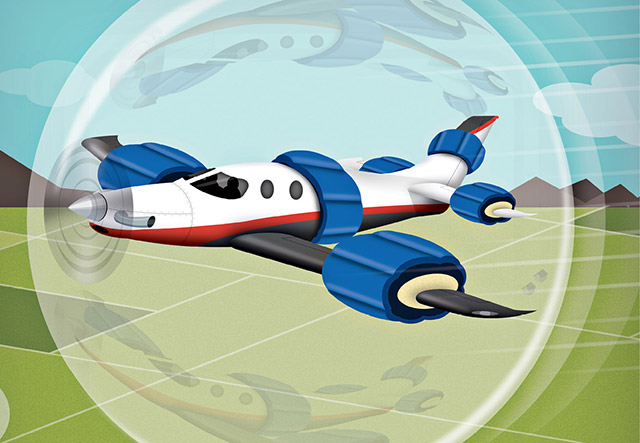
Automating for safety
When most of us think about turbine aircraft, we tend to focus on their speed, mission profiles—and price. However, they also have served as the harbingers of generations’ worth of safety features, well worth those lofty price tags. Accidents are recorded, not “saves,” so we’ll never know to what extent the following turbine warning/safety systems were responsible for holding down the turbine accident rate. But know this: Most came about because of lessons learned from accident investigations. And many of these technologies have already begun to trickle down to some piston singles and twins.
If there are themes running through these safety systems, they are automation and precision. And it’s all for the good. It’s worth remembering that autopilot and autoland had their skeptics when those technologies were new. What’s next? A futurist might say autonomous airplane control, capable of taking off and landing without any human input at all. But that’s a long way off. Or is it? At least one general aviation manufacturer—Diamond Aircraft—is already at work on the idea.
Illustration by John Ueland
1. Cabin altitude alerts
Whether it’s a chime or a warning-light annunciation, alerts of elevated cabin altitudes have long been a staple on the panels of pressurized airplanes. Typically, when a pressure sensor within the cabin detects cabin altitudes at or above a certain threshold—say, 10,000 feet—the pilot gets the warning. It’s a reminder to put on your oxygen mask, check the pressurization system for abnormalities, and make an emergency descent.
2. Emergency descent mode (EDM)
With the advent of integrated flight control systems and more sophisticated digital flight logic parameters, EDM has become more common. An EDM system is designed to take over if hypoxia incapacitates the pilot. If the system doesn’t detect any pilot inputs when the airplane is flying at hypoxia-inducing altitudes, power is automatically reduced and a descending bank initiated at a prescribed airspeed. A steep descent ensues. At a safe, preset altitude where oxygen levels are suitable, the airplane automatically levels off without pilot input.
3. Takeoff configuration warning systems
These systems issue pretakeoff aural warnings if the airplane is not configured properly. Some systems let the pilot press a switch to initiate a check, or automatically sound off when power is advanced. For example, “No takeoff, flaps,” if the flaps are not in the takeoff position, or “No takeoff, trim,” if trim settings are incorrect. Several fatal crashes have been traced to inadvertent no-flaps takeoffs, which helped to prompt the wider use of takeoff warning systems.
4. Ice detection probes/alert systems
More aircraft have adopted the use of ice-detection probes. These vibrate at a certain frequency and are designed to trigger an alert when the frequency of the vibration decreases from ice accretions. A signal is sent to an annunciator panel, and in some applications the airplane’s ice-protection system may be automatically activated. These probes detect the onset of icing conditions far in advance of a pilot’s ability to eyeball any potential buildups.
5. Smart probes
Speaking of probe technology, a new generation of what are being called smart probes is now entering service. Smart probes detect airspeed and look like typical pitot tubes, but they also serve as self-contained air data systems, and calculate angle of attack. They are connected to the flight instruments via a digital data bus, so there is none of the leakage-prone pneumatic tubing of a conventional pitot-static system. Nor is there any pressure lag, delay in data transmission, or requirement for pressure checks. There are dual probes for redundancy, and if a unit needs to be replaced it’s a simple matter to swap it out with a new one.
6. Enhanced vision systems (EVS)
EVS uses infrared sensors to deliver startlingly accurate depictions of the terrain and runway environment ahead—even at night or when clouds, fog, or mist are present. Traditionally, we think of infrared imagery as being projected on head-up displays (HUDs), which themselves are becoming more commonplace. The pilot flips down a HUD’s combiner plate and voilà, there’s the forward view, together with attitude, airspeed, altitude, heading, track, wind, and navigation information—all in one place, so the pilot can concentrate on the procedure at hand without being “head down” and alternating between scanning the instrument panel and looking up for the runway. Now comes a promising, combined vision technology that merges synthetic vision with infrared; the infrared imagery is embedded within the wider, synthetic view. Think of it as picture-in-picture. This has been projected on HUDs, but also within primary flight display backgrounds. For pilots flying instrument approaches in low weather, combined vision systems represent the ultimate in situational awareness—so much that credit for descending to minimums below standard Category I levels is being aggressively pursued.
10. Fly-by-wire
Last but most certainly not the least among the newer safety technologies is fly-by-wire. Fly-by-wire does away with the push rods, cables, bellcranks, and other hardware that actuate the flight controls of conventional aircraft, and replaces them with digital commands. So when you move a control stick, you’re really moving electrons along a predetermined pathway; any control “feel” or feedback is provided by springs or tensioners meant to mimic what we expect. Meanwhile, multiple electronic flight computers ensure that the airplane’s movements follow your—or the autopilot’s—commands, while preventing it from exceeding the authorized flight envelope. The computers follow two or more levels of control laws that ensure redundancy. Hand-flying a fly-by-wire airplane is a breeze (although most fly-by-wire airplanes are principally flown on autopilot). Simply take up a heading that makes good your desired track, set a climb airspeed or rate, and release the controls. Fly-by-wire takes it from there. If you were flying alongside the airplane in formation, you’d notice the fly-by-wire airplane’s ailerons and elevators automatically moving so as to preserve the selected path, without any pilot intervention. Fly-by-wire’s control laws will make sure the airplane remains within safe bank and pitch limits, won’t exceed G limits, and won’t stall or overspeed. In fact, fly-by-wire’s interface with FADEC controls will command autothrottles to add power should dangerously high angles of attack develop, and reduce power in high-speed dives. While controversial, there’s no doubt that fly-by-wire can control an airplane more precisely than any human, and that its system reliabilities exceed those set down in certification rules.
Safety in a small package
iPads deliver portable tech
While many aviationtechnologies launch in jetsand then trickle down to lighter general aviation, the Apple iPad quickly made its way to aircraft of all sizes.
Part 135 operators mustreceive approval from an FAA inspector before using theiPad as a Class 1 electronic flight bag, a process thatincludes showing that thedevice has gone throughrapid decompression andnoninterference testing. Jeppesen has shown the device can withstand rapid decompression at altitudes of 51,000 feet in testing.
But for most Part 91operations, pilots need no authorization to use an iPad in flight. Pilots can display moving-map charts andapproach plates, calculate weight and balance, check fuel costs, and even displaysynthetic vision on an iPad. The lightweight tablet can act as a standalone EFB, or it may sync with certain avionics to display traffic and weather on the tablet or load flight plans to the panel.
Pilots can supplement cockpit technology with safetyfeatures in a low-cost portable device. The barometer sensor built in to the iPad Air 2enables aviation appForeFlight to alert pilots when they’re crossing through 12,000 feet msl and 25,000 feet msl. Most major EFB developers can deliver backup attitude information orsynthetic vision as an option. —Sarah Deener
7. Automated fuel tank switching
Turbine aircraft have large-capacity fuel systems and can gulp fuel at a high rate. A distracted pilot can forget to switch tanks in a timely way, and end up with an unbalanced fuel load that meets or exceeds published limitations. To preserve adequate and safe lateral control through the ailerons, it’s critical to keep fuel loads balanced between wings. For this reason, many modern airplanes now incorporate automatic tank switching. The rate at which tanks are switched varies according to fuel consumption, so fuel is always balanced well within limits—all without any pilot workload. Should the system fail, manual switching is possible.
8. Datalinked trend monitoring
Sure, engine health can be determined by performing on-wing or off-wing inspections and measurements, but now this information can simply be downloaded to a laptop during the next scheduled—or unscheduled—shop visit. So can a history of any avionics or crew advisory and warning system (CAWS) messages. Data-logging hardware and software is now routinely used for all sorts of troubleshooting, and the latest technology lets you download the airplane’s status and discrepancies via Wi-Fi connections on the ground, or in flight via a satellite transceiver. Now hours’ worth of flight data can be downloaded in seconds.
9. Full authority digital enginecontrol (FADEC)
In a word, FADEC eliminates mechanical connections between power controls (thrust, propeller, condition, and fuel shutoff levers) and their target components, often replacing them with a single lever that incorporates all those functions. An engine control unit protects the engine against exceedances and allows precise power settings for ambient atmospheric conditions. There are other big advantages: pushbutton starting, redundant control pathways, optimal fuel economy, and logic that can support automatic functions such as stall recovery. It’s those precise power settings that do the most to lower pilot workload. Advance the thrust lever(s) to preset detents in the control runs and you’ll get optimal engine performance for the selected flight regime, without the need to consult and decipher power tables. So when you go to the MAX CRZ detent, for example, you’ll automatically receive the correct setting for maximum cruise speed performance, no matter the altitude or temperature.



